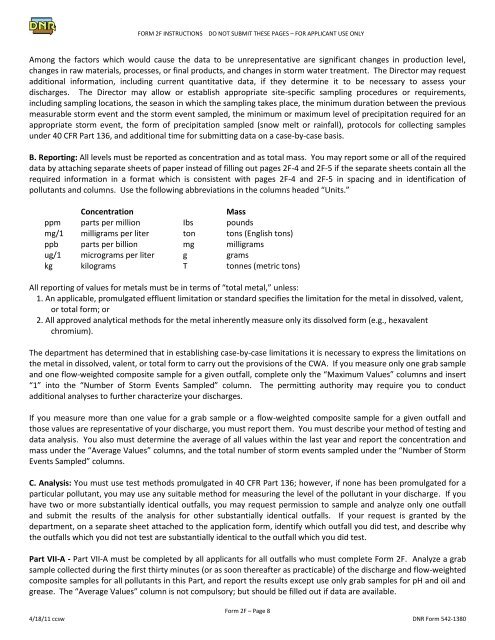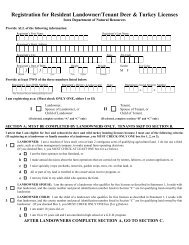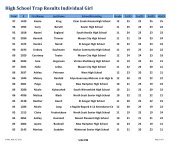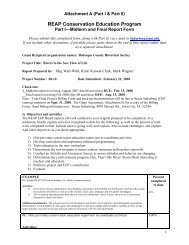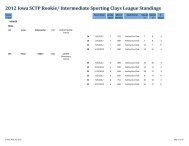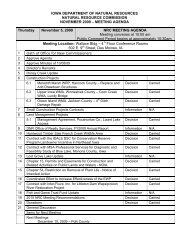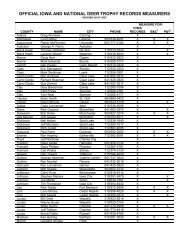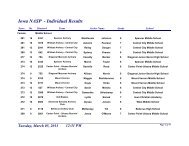iowa department of natural resources npdes permit application
iowa department of natural resources npdes permit application
iowa department of natural resources npdes permit application
You also want an ePaper? Increase the reach of your titles
YUMPU automatically turns print PDFs into web optimized ePapers that Google loves.
FORM 2F INSTRUCTIONS DO NOT SUBMIT THESE PAGES – FOR APPLICANT USE ONLY<br />
Among the factors which would cause the data to be unrepresentative are significant changes in production level,<br />
changes in raw materials, processes, or final products, and changes in storm water treatment. The Director may request<br />
additional information, including current quantitative data, if they determine it to be necessary to assess your<br />
discharges. The Director may allow or establish appropriate site-specific sampling procedures or requirements,<br />
including sampling locations, the season in which the sampling takes place, the minimum duration between the previous<br />
measurable storm event and the storm event sampled, the minimum or maximum level <strong>of</strong> precipitation required for an<br />
appropriate storm event, the form <strong>of</strong> precipitation sampled (snow melt or rainfall), protocols for collecting samples<br />
under 40 CFR Part 136, and additional time for submitting data on a case-by-case basis.<br />
B. Reporting: All levels must be reported as concentration and as total mass. You may report some or all <strong>of</strong> the required<br />
data by attaching separate sheets <strong>of</strong> paper instead <strong>of</strong> filling out pages 2F-4 and 2F-5 if the separate sheets contain all the<br />
required information in a format which is consistent with pages 2F-4 and 2F-5 in spacing and in identification <strong>of</strong><br />
pollutants and columns. Use the following abbreviations in the columns headed “Units.”<br />
ppm<br />
mg/1<br />
ppb<br />
ug/1<br />
kg<br />
Concentration<br />
parts per million<br />
milligrams per liter<br />
parts per billion<br />
micrograms per liter<br />
kilograms<br />
Ibs<br />
ton<br />
mg<br />
g<br />
T<br />
Mass<br />
pounds<br />
tons (English tons)<br />
milligrams<br />
grams<br />
tonnes (metric tons)<br />
All reporting <strong>of</strong> values for metals must be in terms <strong>of</strong> “total metal,” unless:<br />
1. An applicable, promulgated effluent limitation or standard specifies the limitation for the metal in dissolved, valent,<br />
or total form; or<br />
2. All approved analytical methods for the metal inherently measure only its dissolved form (e.g., hexavalent<br />
chromium).<br />
The <strong>department</strong> has determined that in establishing case-by-case limitations it is necessary to express the limitations on<br />
the metal in dissolved, valent, or total form to carry out the provisions <strong>of</strong> the CWA. If you measure only one grab sample<br />
and one flow-weighted composite sample for a given outfall, complete only the “Maximum Values” columns and insert<br />
“1” into the “Number <strong>of</strong> Storm Events Sampled” column. The <strong>permit</strong>ting authority may require you to conduct<br />
additional analyses to further characterize your discharges.<br />
If you measure more than one value for a grab sample or a flow-weighted composite sample for a given outfall and<br />
those values are representative <strong>of</strong> your discharge, you must report them. You must describe your method <strong>of</strong> testing and<br />
data analysis. You also must determine the average <strong>of</strong> all values within the last year and report the concentration and<br />
mass under the “Average Values” columns, and the total number <strong>of</strong> storm events sampled under the “Number <strong>of</strong> Storm<br />
Events Sampled” columns.<br />
C. Analysis: You must use test methods promulgated in 40 CFR Part 136; however, if none has been promulgated for a<br />
particular pollutant, you may use any suitable method for measuring the level <strong>of</strong> the pollutant in your discharge. If you<br />
have two or more substantially identical outfalls, you may request permission to sample and analyze only one outfall<br />
and submit the results <strong>of</strong> the analysis for other substantially identical outfalls. If your request is granted by the<br />
<strong>department</strong>, on a separate sheet attached to the <strong>application</strong> form, identify which outfall you did test, and describe why<br />
the outfalls which you did not test are substantially identical to the outfall which you did test.<br />
Part VII-A - Part VII-A must be completed by all applicants for all outfalls who must complete Form 2F. Analyze a grab<br />
sample collected during the first thirty minutes (or as soon thereafter as practicable) <strong>of</strong> the discharge and flow-weighted<br />
composite samples for all pollutants in this Part, and report the results except use only grab samples for pH and oil and<br />
grease. The “Average Values” column is not compulsory; but should be filled out if data are available.<br />
Form 2F – Page 8<br />
4/18/11 ccsw DNR Form 542-1380


